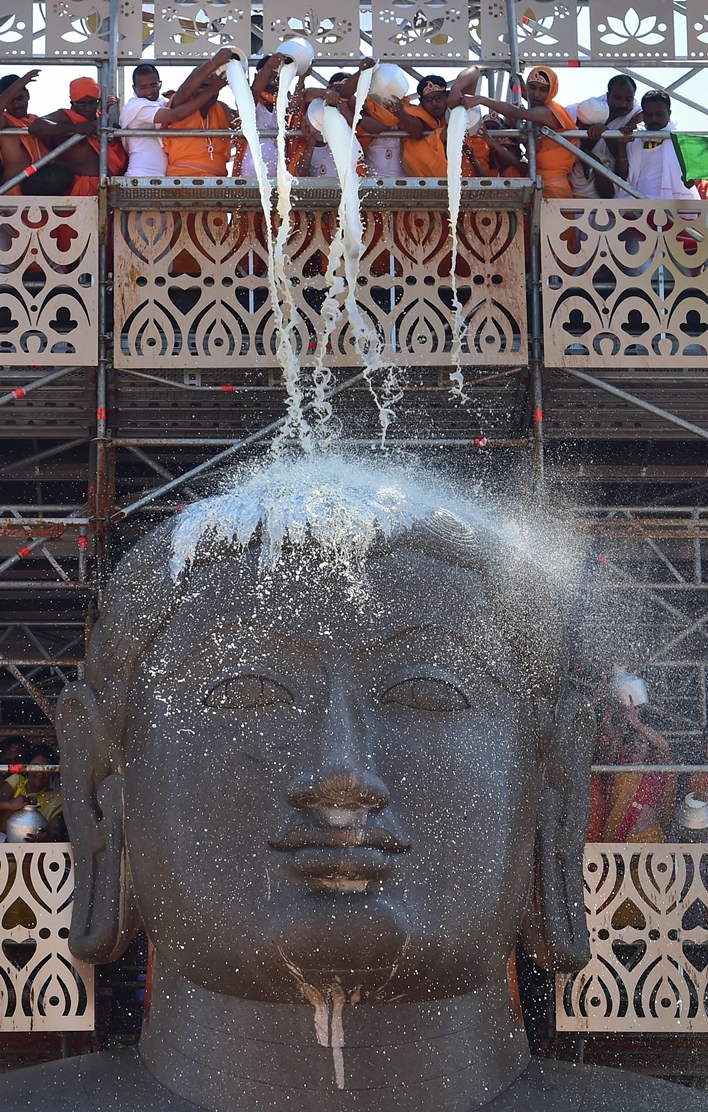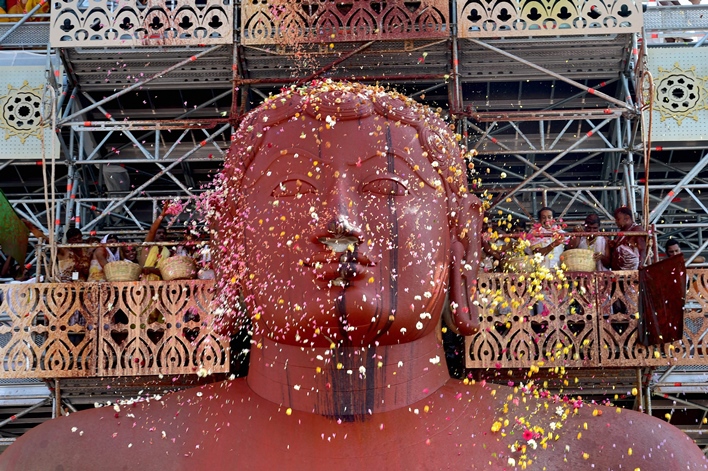Mahamastakabhisheka history – the celebration has a mesmerizing history and let us find out.
Legend has it that the reverend Jain deity Bahubali lived in Ayodhya, but his presence is prevalent across Jains in South India as well, especially in the state of Karnataka. The religious festival, Mahamastakabhisheka, literally translated as ‘grand consecration’, is celebrated with much grandeur and fanfare by the Jain community in India, to venerate Bahubali and other Jain deities.

Shravanabelagola: Devotees pour milk on the 58 feet monolithic statue of Gomateshwara or Lord Bahubali on the second day of the 88th Mahamasthakabhishek in Shravanabelagola in Hassan district
The ceremony is an essential part of the Jain culture and is conducted once in every 12 years. The most famous of the Mahamastakabhisheka festivals is the anointment of the Bahubali Gommateshwara Statue at Shravanbeloga in Hassan, Karnataka. Standing tall at 58.8-foot, the Gommateshwara statue is the biggest in India and one of the largest free standing statues in the world. It was erected in 981 AD with great expertise by master craftsmen across the local area.
Mahamastakabhisheka History – The story behind the ritual
According to the legend, Bahubali was the son of Rishabhadeva, the first tirthankara of Jainism. When Rishabhadeva decided to become an ascetic, he abandoned his worldly possessions and divided his property between his two sons. While Ayodhya was given to Bahubali’s elder brother, Bharata, Bahubali received the kingdom of Podanpur.
Even though Bharata had a kingdom of his own, he soon started envying the saint, as Podanpur was prospering in every way. So he decided to fight his brother in order to conquer Podanpur. The battle involved only the two brothers, which resulted in Bharata’s loss. Infuriated, Bharata threw a chariot wheel at Bahubali, which didn’t affect him due to its divine powers.
The saint was saddened that his brother was so lost in his hunger for power, that he could fight his only brother. He then decided to follow his father’s footsteps by renouncing his property. He stood right there on his brother’s land, meditating on his feet, begging God for forgiveness. Even though he was observing meditation and penance for many years, he couldn’t attain enlightenment. Thoughts that he was still standing in Bharata’s land affected his reflections.
The day he stopped thinking where he is, he attained enlightenment and salvation. When Bharata received the news of Bahubali’s enlightenment, he ordered a gold idol of Bahubali to be constructed and installed at Podanpur. Since then devotees have been constructing statues of Bahubali and venerating them reverently on the occasion of Mahamastakabhisheka. The majestic Gommateshwara statue was believed to be built by Chamundaraya in 981 AD, after being directed to do so in an apparition.

Devotees offer prayers near the 57-foot-high monolithic Gomateshwara statue on Vindyagiri in Shravanabelagola, around 160 km west of Bengaluru on Wednesday. Thousands of Jain devotees will attend the Mahamastakabhisheka (head anointing ceremony) on February 17.
References of Mahamastakabhisheka history in the holy inscriptions
Theology experts have been curious how Mahamastakabhisheka Mahotsav had been celebrated in ancient times, and if it was celebrated lavishly like recent times. The Mahamastakabhisheka history dates back to the times of Jain inscriptions. There are many references to the festival briefly mentioned in the Jain inscriptions.
According to the religious books, the earliest Mahotsav was performed seven times by Panditarya. Other references site that the ritual was performed by a Santavarni in 1612, by Anantakavi, a Jain minister of the Mysore king Chikka Deva Raja Odeyar in 1677, and by the Mysore king Krishna-Raja-Odeyar III in 1825. The festival has also been mentioned in historical journals such as The Indian Antiquary and The Harvest Field in detail.

Shravanabelagola: Devotees offer flower petals on the 58 feet monolithic statue of Gomateshwara or Lord Bahubali on the second day of the 88th Mahamasthakabhishek in Shravanabelagola in Hassan district, some 150 km from Bengaluru
Mahamastakabhisheka History – How pilgrims celebrate the occasion
Pilgrims from various states of India visit Shravanbeloga to celebrate Bahubali Mahamastakabhisheka Mahotsav with great fervor. The preparation of the grand feast is done well in advance.
The statue is anointed with purified water and sandalwood paste, as an act of reverence. On the main day of the festival, holy water is sprinkled upon the devotees who will be carrying 1008 pots to anoint the statue with a variety of items including coconut milk, sugarcane juice, turmeric paste, jaggery, ghee, sandalwood, dates, poppy seeds, rice and a variety of fresh flowers. The devotees then ascend the stairs (650 steps for this masterpiece) to reach the top of the statue and shower the idol, chanting mantras while doing so. Some people offer silver and gold coins as an offering. The duration of the complete ceremony is around 10 hours.

Mahamastakabhisheka. Image courtesy Hnvijay
The on-going Mahamastakabhisheka festival
2018 is an auspicious year for Jains as the celebrations of Mahamastakabhisheka kicked off earlier last month. This will be the 88th festival of its kind. The festival has upgraded the status of Shravanbeloga to a pilgrimage destination. Millions of Jain worshippers flock to Shravanabelagola to commemorate Bahubali on this auspicious day.
Honorable PM Narendra Modi also attended the ceremony, as a part of his Karnataka trip agenda, and viewed the enormous monolithic statue. He later addressed the crowd and spoke about the contribution of saints and seers in transforming the society.
The Shravanabelagola Art Festival was conducted as a part of the festival from 25th to 28th January 2018. Around 50 talented artists got the opportunity to showcase their art. A second leg of the art festival is being conducted from 17th to 25th February, where more artworks will be exhibited.